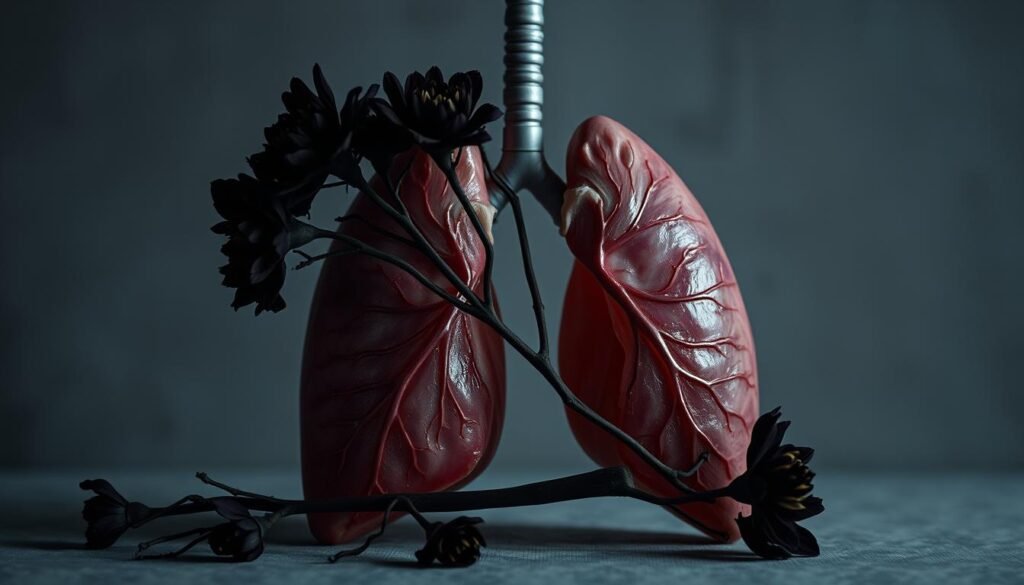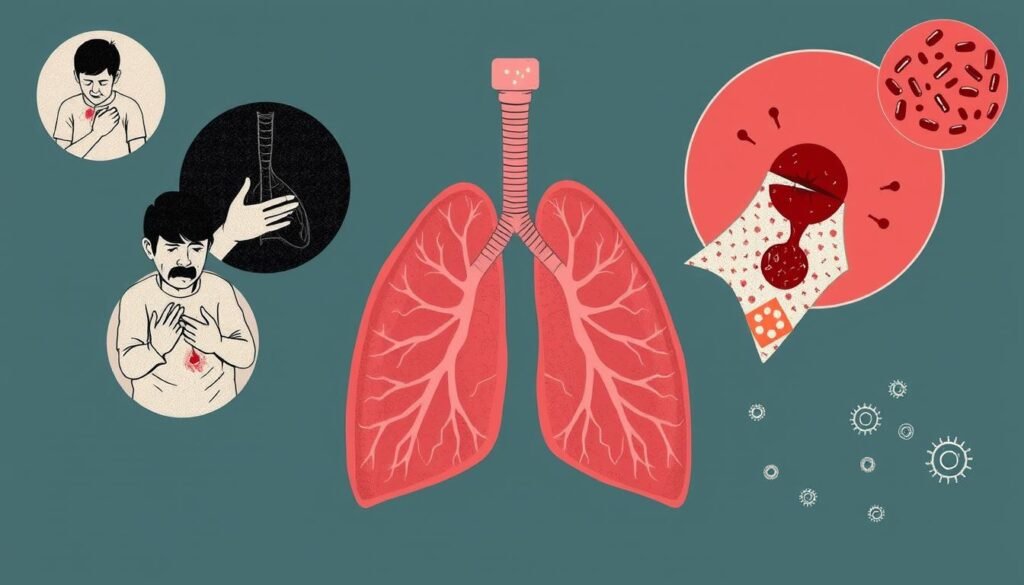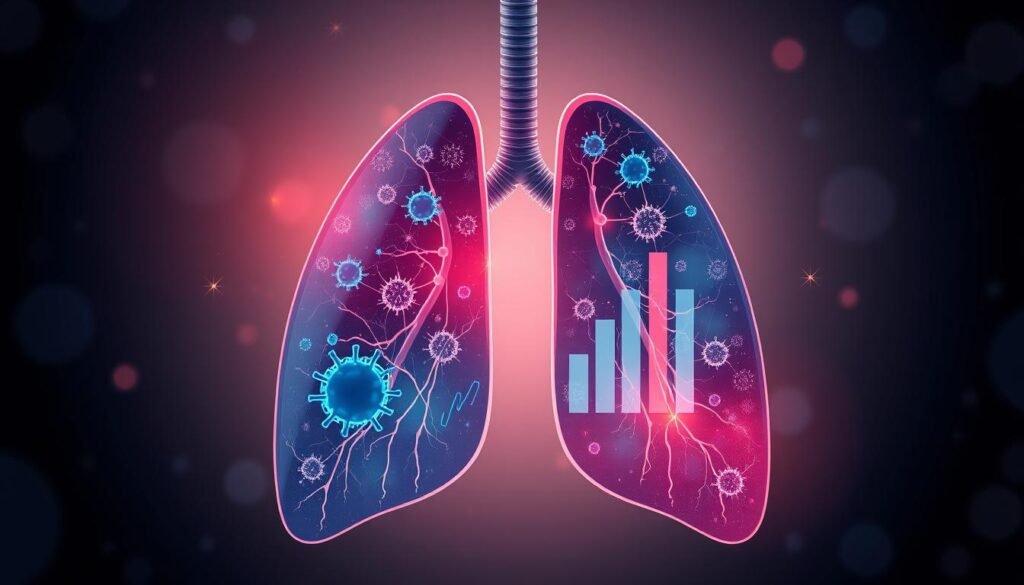Did you know that more than 80% of lung cancer patients don’t survive past five years after their diagnosis? This fact highlights the serious danger lung cancer holds. It’s the top cause of cancer-related deaths worldwide, especially in the United States. This article will look into lung cancer’s effects on health and survival. We will also check out important statistics about this disease.
Understanding what makes lung cancer so deadly is crucial. Factors include the size of the tumor, spread to other bodily zones, and infections. Knowing these can help grasp how serious this disease can be. This knowledge lets caregivers provide better care towards life’s end and manage symptoms well. We’ll explore lung cancer stages, symptoms, and treatment options. All to answer the question: can lung cancer kill you?
Key Takeaways
- Over 80% of lung cancer patients die within five years of diagnosis.
- Lung cancer is the leading cause of cancer death in the United States.
- Understanding lung cancer risks is essential for timely treatment and end-of-life care.
- Common causes of death in lung cancer include tumor burden and infections.
- Recognizing symptoms can significantly impact survival rates.
Lung Cancer Overview
Lung cancer is a major health issue around the world. It’s the top reason for cancer deaths globally. Every year, millions are impacted. Learning about lung cancer is crucial for realizing how serious it is and its ties to risk factors. Smoking is behind about 85% of cases, making it the biggest risk. In 2020, lung cancer was responsible for an estimated 1.8 million deaths.
What is Lung Cancer?
Lung cancer starts when abnormal lung cells grow out of control. Often, there are no early symptoms, leading to late discoveries. Knowing the types of lung cancer is key for better treatment and survival. Preventing it can involve controlling tobacco use and reducing environmental risks.
Types of Lung Cancer
Lung cancer mainly comes in two forms: small cell and non-small cell. Non-small cell lung cancer (NSCLC) is more common but grows slower. Small cell lung cancer (SCLC) is rarer but spreads quicker. Understanding these types is important. It guides treatment options and affects how patients respond. Knowing these details can improve survival rates with early screening.
| Type of Lung Cancer | Growth Rate | Commonality |
|---|---|---|
| Small Cell Lung Cancer (SCLC) | Rapid | Less Common |
| Non-Small Cell Lung Cancer (NSCLC) | Slow | Most Common |
The Statistics Behind Lung Cancer Deaths
Lung cancer is a major public health issue in the United States. It is the leading cause of death among all cancers. About 125,070 Americans die from it each year.
This number is nearly three times higher than deaths from prostate cancer in men. And three times higher than deaths from breast cancer in women.
Lung Cancer as a Leading Cause of Death
Lung cancer is very common and deadly. In 2024, around 234,580 people will get diagnosed. This shows how serious lung cancer is.
About 1 in 16 people will be diagnosed in their lifetime. The survival rate has gone up to 28.4% in the last five years. However, lung cancer is still a major challenge in the cancer battle.
Lung Cancer Fatality Rates in the United States
More than half of the patients die within a year of finding out they have lung cancer. This fact shows why it’s crucial to catch the disease early. Late detection often results in higher death rates.
Screening, like yearly low-dose CT scans, can help. They could lower death rates by up to 20%. In March 2021, screening guidelines were widened to include more people at risk.
Yet, only 16.0% of those eligible got screened last year. This shows a need for more awareness and participation.
These statistics highlight a grave situation. Screening rates for at-risk groups differ greatly by state. They range from 8.6% in Wyoming to 28.6% in Rhode Island.
These stats are more than numbers. They show a health crisis that needs more attention, funding, and preventive actions.
Understanding the Stages of Lung Cancer
Lung cancer is grouped into stages that show how far it has spread. This helps doctors plan treatment. Knowing about these stages is crucial for patients and their families. It helps them make smart decisions about care. This part talks about end-stage lung cancer and how the disease gets worse.
What is Terminal Lung Cancer?
Stage 4 lung cancer is also called terminal lung cancer. At this stage, the cancer has spread to other parts of the body. People’s health gets much worse. They may cough a lot, feel out of breath, and lose weight without trying. At this point, the chance of living for many more years is very low. Finding the cancer early is very important to have a better chance of survival.
The Progression of Lung Cancer Stages
Lung cancer moves through different phases. Doctors classify them by how severe they are and how far the cancer has spread:
| Stage | Description | 5-Year Survival Rate |
|---|---|---|
| Occult | Finding the cancer is hard. It might show up in sputum or lung washings. | Varies |
| Stage 0 | There are abnormal cells but no spreading. This includes adenocarcinoma in situ. | Not applicable |
| Stage 1 | Cancer is present. It’s split into 1A (no lymph nodes affected) and 1B (bigger tumor). | 62.8% |
| Stage 2 | The tumor grows more, and lymph nodes might be involved. It’s split into 2A and 2B. | 34.8% |
| Stage 3 | Cancer has spread more, with types 3A, 3B, and 3C based on lymph node and organ involvement. | 41% (3A) |
| Stage 4 | The cancer has reached distant organs, with types 4A and 4B depending on how far it has spread. | 6% |
Knowing how lung cancer gets worse is key to getting help early. Catching the cancer when it’s still in early stages can really improve someone’s chances. Cancers found early are much easier to treat than those found later.
Can Lung Cancer Kill You?
Lung cancer is one of the deadliest forms of cancer, highly affecting mortality rates. It’s crucial to understand why lung cancer is so fatal to comprehend its threats. Patients with lung cancer face numerous issues due to the cancer’s spread in their bodies.
Examining the Causes of Death in Lung Cancer Patients
The reasons for high death rates among lung cancer patients are varied. Those with weakened immune systems may suffer from infections. On the other hand, cancer spreading to vital organs can have dire consequences. Common fatal outcomes for these patients include:
- Infections
- Pulmonary hemorrhage
- Embolism
- Organ failure due to tumor spread
Studies show that most lung cancer patients die within five years of finding out they have it. Catching the cancer early is critical to enhance survival chances for patients of various backgrounds. It leads to better chances for effective treatment.
Understanding Tumor Burden and Its Impact on Survival Rates
The amount and spread of cancer, known as tumor burden, greatly affect patient outcomes. A large tumor burden means worse survival chances. It causes severe symptoms and problems, complicating treatment efforts. Targeting these issues through treatment does not guarantee a cure but aims to improve living conditions.

New treatments like chemotherapy, radiation, and targeted therapies help manage the disease and enhance life quality. Knowing how tumor burden evolves and its consequences is key for patients and their families. For more details on lung cancer’s spread and its severity, check out this helpful resource.
| Cause of Death | Description |
|---|---|
| Infections | Frequent complications due to a compromised immune system. |
| Pulmonary hemorrhage | Severe bleeding within the lungs affecting respiratory function. |
| Embolism | Obstruction of blood vessels by clots, leading to reduced blood flow. |
| Organ failure | Critical failure of organs as a result of extensive cancer spread. |
Risk Factors for Lung Cancer Mortality
Looking into lung cancer mortality’s risk factors helps with prevention and treatment. Smoking is the top cause of lung cancer, greatly affecting death rates. The link between how much and how long one smokes shows a risk increase up to ten times versus non-smokers. Even those who quit smoking continue to face high risks for years, showing smoking’s long-lasting effects.
Smoking and Secondhand Smoke
Secondhand smoke is also a major risk, affecting people who don’t smoke. Being around cigarette smoke increases the chance of getting lung cancer. Many lung cancer deaths among non-smokers are due to secondhand smoke.
Other Contributing Health Conditions
Other health issues also play a role in lung cancer. Diseases like heart problems, high blood pressure, and diabetes can lower survival chances. These conditions highlight the need for treating lung cancer patients with a broad medical approach. Past cancer treatments, especially with radiation, and environmental risks like radon exposure add to lung cancer risks.
For more details on lung cancer risk factors, check out reliable studies like the one found here.
Symptoms of Lung Cancer
Noticing lung cancer symptoms early can really change how treatment goes. Often, these symptoms start slowly, so it’s key to know them. If you see these signs, it’s time to talk to a healthcare expert.
Common Symptoms to Watch For
The symptoms of lung cancer can range in how serious they are. They can include:
- Persistent cough: A cough that stays or gets worse could be an early warning.
- Chest pain: Pain in the chest area might point to lung problems.
- Hemoptysis: Coughing up blood or rust-colored sputum is worrying.
- Shortness of breath: Struggling to breathe during everyday activities means you should see a doctor.
- Fatigue: Feeling unusually tired or weak and it’s affecting your day could be a sign.
- Weight loss: Losing a lot of weight without trying? That’s an alert.
Recognizing Severe Symptoms That Require Emergency Care
It’s vital to know the emergency signs of lung cancer that need quick medical help. Serious symptoms include:
- Increased shortness of breath: A sudden or big increase in breathing trouble is bad news.
- Extreme fatigue: If you’re so tired it messes with daily life, that’s a red flag.
- Pain: Constant or very bad pain in the chest or another place that usual painkillers don’t help.
- Neurological problems: Issues like headaches, feeling confused, or having seizures could mean the cancer has spread to the brain.
- Signs of pulmonary embolism: Sudden chest pain, trouble breathing, and a fast heartbeat need immediate attention.

Knowing when to seek urgent care is key in dealing with lung cancer. Being aware of all lung cancer symptoms helps you make smart health decisions.
Treatment Options and Their Efficacy
Lung cancer treatments differ greatly, based on the disease’s type and stage. Strategies often mix surgery, chemotherapy, and radiation. Each plays a key part in managing the disease and improving outcomes. Such treatments can greatly boost survival rates and life quality.
Current Treatments for Lung Cancer
For non-small-cell lung cancer, surgery is often the first step. It aims to take out cancer cells and might be followed by chemotherapy to increase success. The main surgical methods are:
- Lobectomy: Removing one lung lobe.
- Pneumonectomy: Taking out an entire lung.
- Wedge resection: Cutting out a small lung section with the tumor.
Treatment for small-cell lung cancer usually means chemotherapy, added with radiotherapy or immunotherapy. Options for radiotherapy include:
- External beam radiotherapy: Uses high-energy rays against cancer.
- Stereotactic radiotherapy: Gives focused radiation to limit damage to nearby tissues.
Unfortunately, treatments like radiation can cause side effects, including fatigue and hair loss. Chemotherapy is given in cycles, with breaks for recovery. Sadly, many patients don’t survive a year after diagnosis, and the 5-year survival rate is under 18%.
Exploring Palliative and Hospice Care
As lung cancer advances, palliative care turns vital. It aims to ease symptoms, improve life quality, and offer emotional support. Palliative care may accompany curative treatments but can shift to hospice care as the disease advances. Hospice care focuses on comfort when treatments can’t cure.
| Treatment Type | Applicable Cancer Type | Main Goals |
|---|---|---|
| Surgery | Non-small-cell lung cancer | Remove cancerous tissue |
| Chemotherapy | Small-cell lung cancer | Slow the spread and manage symptoms |
| Radiation Therapy | Both types | Control or eliminate tumors |
| Palliative Care | All stages | Symptom management and quality of life |
| Hospice Care | End-stage cancer | Comfort and support for patients and families |
Lung Cancer Prognosis and Survival Rates
The chances of beating lung cancer depend on many things. These include how early it’s found, the patient’s age, and overall health. Knowing what affects outcomes is key for people with this illness. Getting treated quickly and properly can make a big difference in survival.
Factors Affecting Lung Cancer Prognosis
The survival rates change based on lung cancer type and stage. Early-stage lung cancer has a 5-year survival rate of about 64%. But this drops to 37% when it spreads. Stage IV lung cancer survival is just 2.0 months without treatment. Things like age, health, and money troubles can also impact survival. Getting help from financial aid programs can help overcome some hurdles, improving access to care.
Understanding Survival Rates for Different Stages
The outlook for lung cancer can be tough. On average, only about 18.6% live for 5 years after diagnosis. The situation is worse for small cell lung cancer, with a 5-year survival rate of only 3%. Non-small cell lung cancer is a bit better, but metastatic cases have an 8% survival chance. If non-small cell lung cancer isn’t treated, patients live for 5 to 12 months, depending on the cancer stage. Black individuals, especially men, have higher death rates from lung cancer. Knowing the symptoms early and seeing a doctor quickly can greatly improve chances. For early lung cancer signs, see here: early signs of lung cancer.

End-Stage Lung Cancer and Its Implications
For patients and their families, living with end-stage lung cancer is hard. The cancer often spreads far, harming health and life quality. Patients face tough symptoms like severe pain, breathing troubles, and tiredness. Emotions such as fear, feeling alone, and regret also appear. It’s key for families and caregivers to understand these challenges as they help their loved ones.
Living with End-Stage Lung Cancer
Those facing end-stage lung cancer need a lot of support. Palliative care can help, as it focuses on easing discomfort and improving life quality. This care doesn’t aim to cure, but it helps with pain and symptoms, bringing comfort. Family support is vital during this time, as they often need help with their own struggles too.
Preparing for End-of-Life Care
Getting ready for end-of-life care is about planning for the final stage of lung cancer. It involves making advanced directives and discussing hospice services. These steps ensure patients’ wishes are followed. Families benefit from knowing what to expect, so they can make smart choices.
| Key Aspects | Details |
|---|---|
| 5-Year Survival Rate for Lung Cancer | Ranges from 9.5% to 16.8% |
| Palliative Care Focus | Aims to alleviate pain and improve quality of life |
| Stage III and IV Diagnosis Rates | 79% in the USA; 67.6% in the UK |
| Common Emotions in Late Stages | Fear of dying, loneliness, regret |
| Caregiver Challenges | Need for physical and emotional support |
Conclusion
Lung cancer deeply impacts millions around the world, leading to many deaths. In the United States, there were 239,320 new cases and about 161,250 deaths each year. It’s crucial for everyone involved to know how deadly lung cancer can be. Finding and treating it early can make a big difference.
A look at the numbers shows that most people with small cell lung cancer (SCLC) die within a year of diagnosis. This fact underlines the need for quick action. While cancer is a leading cause of death, other health problems also matter, especially after three years. Treating all health issues, not just cancer, is important.
Although lung cancer leads to many deaths, knowledge and action can change the outcome. Knowing about risks, signs, and how to treat lung cancer helps make better decisions. Efforts to reduce smoking and better screening tools offer hope for those facing lung cancer.